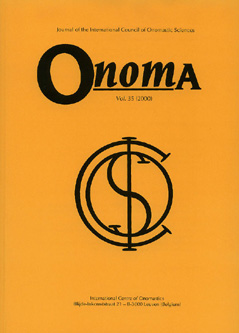 previous article in this issue previous article in this issue | next article in this issue  |

|
Document Details : Title: The Legal Regulation of Married Name Use and Its Practice in Hungary Author(s): FERCSIK, Erzsébet Journal: Onoma Volume: 47 Date: 2012 Pages: 57-80 DOI: 10.2143/ONO.47.0.3085139 Abstract : In Hungary, the legal regulation of married name use started at the end of 19th century. By then, the traditional name form (Kis Jánosné) became pre-eminent among the various name forms, to function as the official name form for married women. In the following periods, the available name forms expanded, and from 2004, not only women, but men could also bear a married name. This study illustrates the linguistic and pragmatic features of women’s married name. It describes the history of the legal regulations for the available name forms at the conclusion and the dissolution of marriage, and the path from the traditional name form to double-barrelled names. By featuring earlier research and statistical data, this study will show the mutual influence that legal regulation and social practice had on each other. It will also demonstrate a few examples to show how other factors such as education and residence influences the choice for names beyond the effect of traditionalism. The growing popularity of names that keep the woman’s birth name or some element of the original name clearly reflects the social changes of women over the last fifty years. En Hongrie, la réglementation juridique du nom d’épouse a été observée à la fin du XIXe s. Déjà, la forme du nom traditionnel (Kis Jánosné) était devenue prépondérante par rapport aux autres formes, jusqu’à devenir le nom officiel des femmes mariées. Par la suite, les formes de nom légalement possibles se sont répandues et, depuis 2004, les hommes peuvent aussi porter le nom de leur épouse. Cette étude illustre les formes linguistiques et pragmatiques du nom d’épouse. Elle décrit l’évolution des lois sur les formes possibles du nom depuis le mariage jusqu’au divorce, et le chemin du nom traditionnel simple au nom double. Au moyen de recherches antérieures et de données statistiques, l’étude montre l’influence mutuelle entre loi et pratique sociale. Par quelques exemples, elle montre aussi comment d’autres facteurs, tels l’éducation ou le lieu de résidence, influent sur le choix du nom au delà de l’effet de la tradition. La popularité croissante des noms qui conservent le prénom de la femme ou un élément de son nom de famille originel reflète bien l’évolution sociale des femmes pendant ces cinquante dernières années. In Ungarn geht die gesetzliche Namenregelung für Verheiratete auf das Ende des 19. Jahrhunderts zurück. Bis dahin hatte sich die traditionelle Namenform (Kis Jánosné) von verschiedenen Varianten zur meistverwendeten entwickelt und wurde damit zur offiziellen Form für verheiratete Frauen. In der Folgezeit vergrößerte sich die Zahl der verfügbaren Namenformeln, und seit 2004 können nicht nur Frauen, sondern auch Männer einen Heiratsnamen annehmen. Dieser Beitrag stellt die linguistischen und pragmatischen Charakteristika des Heiratsnamens von Frauen dar. Er beschreibt die Entwicklung der gesetzlichen Regelung für Namenformen, die bei Heirat und Scheidung in Frage kommen, sowie den Weg vom traditionellen Namen zu den modernen Doppelformen. Durch die besondere Berücksichtigung früherer Untersuchungen sowie statistischer Daten zeigt dieser Beitrag die wechselseitige Beeinflussung von gesetzlicher Regelung und gesellschaftlicher Praxis. Anhand einiger Exemplare illustriert er darüber hinaus, wie bestimmte Faktoren wie Bildung und Wohnort die Namenwahl außerhalb der Einwirkung des Traditionalismus beeinflussen. Die wachsende Popularität von Namen, die den Mädchennamen oder ein Element der ursprünglichen Namenformel beinhalten, spiegelt eindeutig den Umbruch der gesellschaftlichen Stellung der Frau während der letzten fünfzig Jahre wider. |
|
